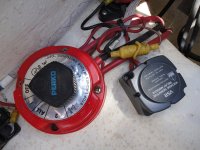My fellow C-Brats, I'd like to share some GREAT news. We bought a boat! And had a DELIGHTFUL shakedown cruise last weekend, about which more in another thread.
In this thread I'm trying to puzzle through a battery charging strategy and I request your help. We have 2 batteries on board - house and start. Each has a battery switch, and they can be combined with an "emergency combine" switch.
In normal operation, I have both battery switches set to ON, and the combiner set to OFF. While underway, the engine alternator charges the start battery only.
My goal is for the engine alternator to charge both batteries while the engine is running. What is the best/safest way to do this? My ideas so far are:
* Combine the batteries by turning the battery combine switch to "combine" BEFORE starting the engine. Possible advantage: no sudden voltage change while engine is running. Possible disadvantage: lower house battery impedes engine's ability to start?
* Combine the batteries by turning the battery combine switch to "combine" AFTER starting the engine. Possible advantage: more fully charged engine battery better for engine start. Possible disadvantage: flipping switch while engine is running not good for engine/alternator/something else I am not thinking of?
In the future, I'd like to install some kind of automatic switch that will do all this automatically in a smart way. This will also minimize the risk that I forget to un-combine the batteries and accidentally drain the start battery while at anchor. My guess is that device will be something like this: http://www.bluesea.com/products/7601/m-Series__Automatic_Charging_Relay_-_12_24V_DC_65A But that is probably a winter project.
For now, I really want to minimize the risk of engine damage while also charging both of my batteries while under way. Can anyone point me in the right direction on this?
In this thread I'm trying to puzzle through a battery charging strategy and I request your help. We have 2 batteries on board - house and start. Each has a battery switch, and they can be combined with an "emergency combine" switch.
In normal operation, I have both battery switches set to ON, and the combiner set to OFF. While underway, the engine alternator charges the start battery only.
My goal is for the engine alternator to charge both batteries while the engine is running. What is the best/safest way to do this? My ideas so far are:
* Combine the batteries by turning the battery combine switch to "combine" BEFORE starting the engine. Possible advantage: no sudden voltage change while engine is running. Possible disadvantage: lower house battery impedes engine's ability to start?
* Combine the batteries by turning the battery combine switch to "combine" AFTER starting the engine. Possible advantage: more fully charged engine battery better for engine start. Possible disadvantage: flipping switch while engine is running not good for engine/alternator/something else I am not thinking of?
In the future, I'd like to install some kind of automatic switch that will do all this automatically in a smart way. This will also minimize the risk that I forget to un-combine the batteries and accidentally drain the start battery while at anchor. My guess is that device will be something like this: http://www.bluesea.com/products/7601/m-Series__Automatic_Charging_Relay_-_12_24V_DC_65A But that is probably a winter project.
For now, I really want to minimize the risk of engine damage while also charging both of my batteries while under way. Can anyone point me in the right direction on this?

